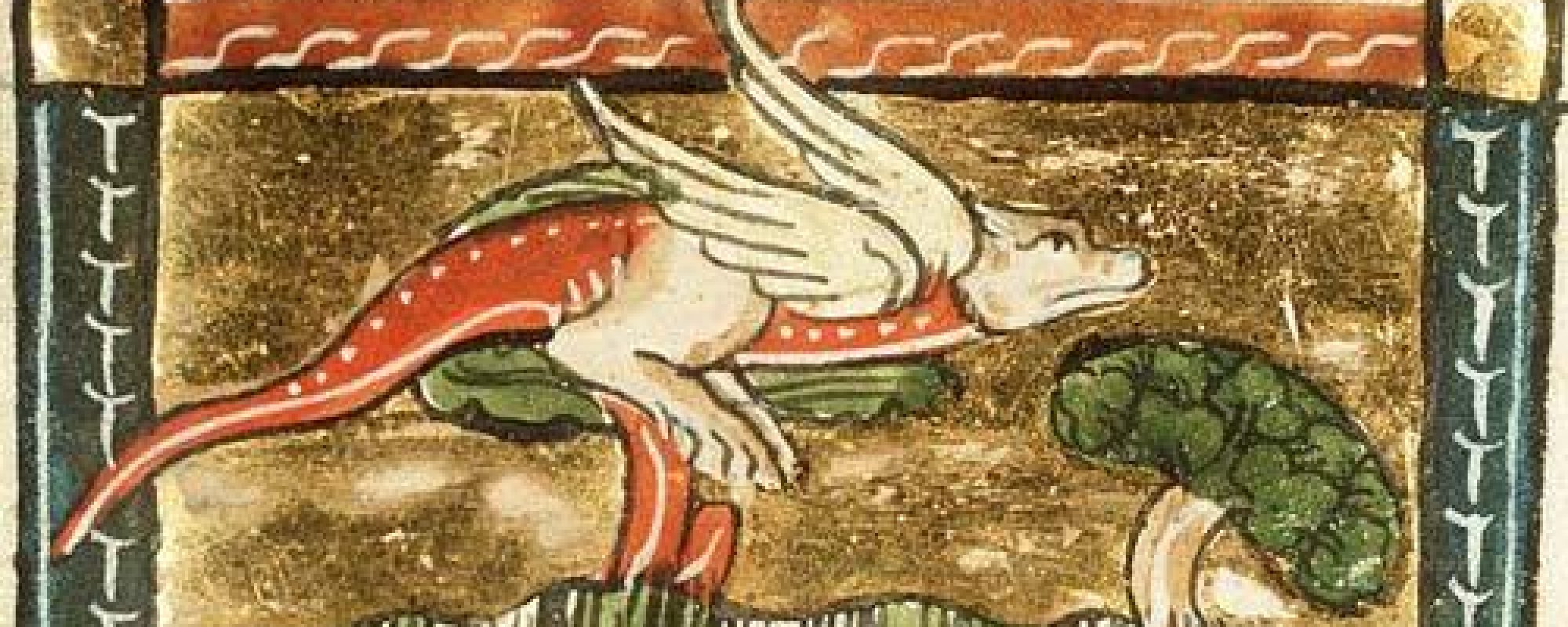Written Analysis
With an ear piercing cry, a dragon lifts itself into the air and soars around a fortress, raining down an abundance of fire strictly from its mere breadth—or so that is how the majority of the populace imagine a dragon attack.
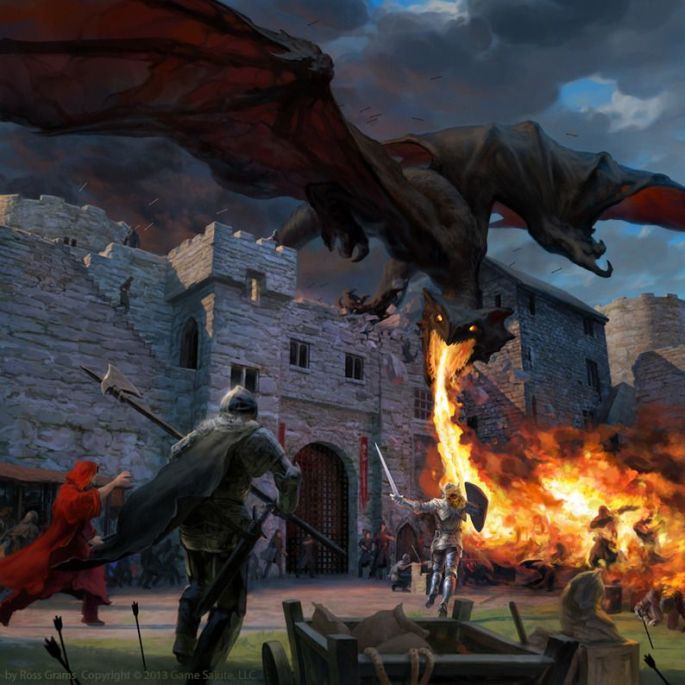
This is an example of the stereotypical dragon attacking a castle. This image can be found on google: https://www.google.com/url?sa=i&rct=j&q=&esrc=s&source=images&cd=&cad=rja&uact=8&ved=2ahUKEwjhnuyAvIjfAhWOneAKHSkQC30QjRx6BAgBEAU&url=https%3A%2F%2Fwww.pinterest.com%2Fpin%2F350647520958491984%2F&psig=AOvVaw2RlpsoibILLK_vCP0JoX-c&ust=1544091637313798.
When one envisions a dragon and possibly the majority of fabulous beasts, it is common to associate them with Medievalism and specifically the Middle Ages. This commonality is a result of the myth that dragons and other mythical creatures existed in the Middle Ages and that people in the Middle Ages believed in such creatures. Regardless of the creatures’ existence, they were often included in Medieval bestiaries and utilized allegorically as a medium for religious teachings.
Did people in the Middle Ages associate dragons with our modern depiction?
Although the modern depictions of a dragon varies slightly, a Medieval audience would have recognized a dragon and its generally associated characteristics from “general cultural awareness.”1Nonetheless, while modern society stereotypically associates dragons as flying, fire breathing monsters, the people in the Middle Ages originally assumed dragons to be a giant snake. As an example, dragons in the Middle Ages were originally known to have “dropped out of trees onto people’s head”: according to Natural Historyby Pliny the Elder, an key text for bestiary writing, “The iaculus throws itself from the branches of trees; dragons are dangerous not only to feet but also fly like a missile from a catapult.”2
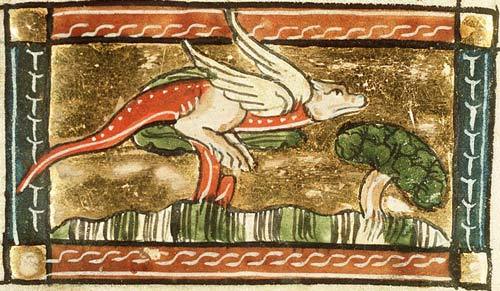
A dragon dropping from a tree–it can be found on the Wikipedia Commons page or Medivialists.net http://www.medievalists.net/2017/04/seven-things-didnt-know-medieval-dragons/
Eventually, dragons are occasionally identified as “flugdrekar—flying dragons—and sometimes simple drekar andormar (“worms”)…as taking to flight.”3Altogether, people in the Middle Ages would have had a more lenient definition of a dragon than the our modern interpretation.
Why were animals—including mythical creatures and specifically the dragon—important in religious environments?
In his introduction, Badke asserts that “animal stories were immensely popular throughout Europe, North Africa, and the Middle East.”4Furthermore, he claims, “there is a distinctly spiritual and even mystical aspect to the animal lore of the middle ages.”5Specifically in the Christian west, Christians “believed the natural world…had been arranged as it was by God to provide a source of instruction to humanity.”6Evidence of this can be found in Job in the Hebrew Bible: “But ask the animals, and they will teach you, or the birds of the air, and they will tell you; or speak to the earth, and it will teach you, or let the fish of the sea inform you. Which of all these does not know that the hand of the Lord has done this? In his hand is the life of every creature and the breath of all mankind.”7While the animals were assumed to instruct humans of God’s natural law, people began to assign different creatures with allegories. For example, people in the middle ages—and also in modern society—typically associated a dragon as the popular “embodiment for Satan.”8In the same regards, people living in the Middle ages would have supported this allegory: “As doves are safe from their enemy the dragon as long as they stay in the shelter of the peridexion tree, so Christians will be safe from their enemy Satan as long as they stay in the shelter of the Church.”9
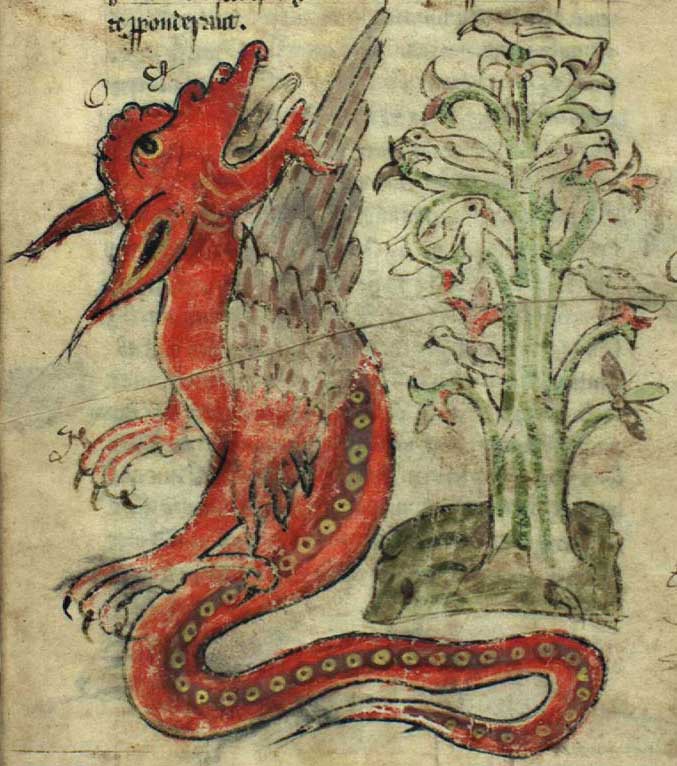
This dragon is unable to devour the doves because they are safe in the tree. This image can be found The Medieval Bestiary Website: http://bestiary.ca/beasts/beastgallery262.htm#.
Whereas the people in the middle ages associated themselves with animals having to combat Satan as a dragon, their literature included Saints explicitly slaying dragons. According to Paul and Karin Johnsgard, the initial “epic battle between man and dragon that comes down to us in any detail is that of Saint George.”10While the accounts of the story vary, it is establishedthat he slayed a dragon because the beast was devouring the a city’s sheep and children and was on route to eat the King’s daughter. However, Pope Clement VII “decreed that George had not been completely truthful about his dragon-killing stories,” so he decided to “eliminate all mention of dragons from St. George’s official biography,” ultimately resulting in George being decanonized.11
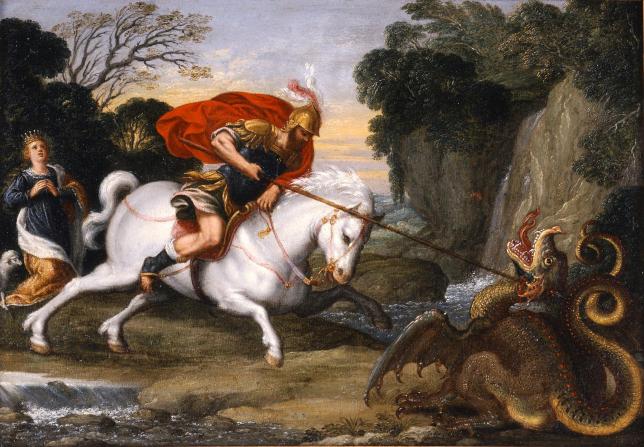
This is an image of Saint George killing a dragon. This image can be found on google: https://www.google.com/url?sa=i&rct=j&q=&esrc=s&source=images&cd=&cad=rja&uact=8&ved=2ahUKEwjr1N7FvYjfAhXxm-AKHS0pCtcQjRx6BAgBEAU&url=https%3A%2F%2Fmetro.co.uk%2F2018%2F04%2F23%2Fsaint-george-actually-kill-dragon-7489287%2F&psig=AOvVaw2KyZlqLgULS1XGduVlc5R-&ust=1544092119271217.
Religious stories involving dragons similar to George’s story can be found throughout Medieval literature, such as Constantinople’s St. Elizabeth the Wonderworker and St. Margaret of Antioch, who is the currently “patron saint of nurses, exiles, Malta, peasants—and childbirth.”12Regardless if the beasts existed or not, they were utilized as “vehicles for moral and religious teaching as the more mundane animals of the European fields and forests.”13
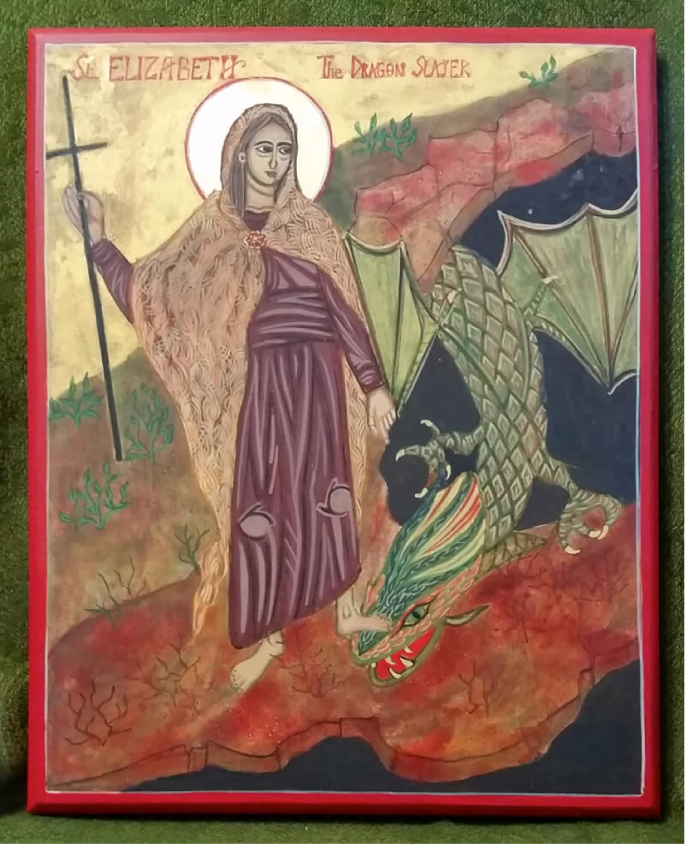
This is an image of Elizabeth of Constantinople as a dragon slayer. This image can be found on google: https://www.google.com/url?sa=i&rct=j&q=&esrc=s&source=images&cd=&cad=rja&uact=8&ved=2ahUKEwiakoPyvojfAhURmuAKHWx3ACsQjRx6BAgBEAU&url=https%3A%2F%2Fwomenandthechurch.org%2Fnews%2Fdragon-slayers-chairs-thoughts%2F&psig=AOvVaw3Qp1ETsJOy0uhVQC3c6o0E&ust=1544092472271323.
What is the origin of the bestiary, and why is it significant to the myths of fabulous creatures?
In essence, a bestiary is a description of a beast and utilizes that “description as a basis for an allegorical teaching.”14Regarding the creation of the bestiary, the Physiologus, a Christian text of interpretations of animal stories as religious allegories, and Isidore of Seville’s Etymologiae, an “encyclopedia of which part was about animals,” were combined into the book “known as the bestiary.”15According to Sobol, “bestiaries circulated widely among monasteries and private owners… [and] consist of brief notices of, usually accompanied by an illustration, of various kinds of mammals, birds, reptiles, and insects.”16While this may sound like an unimportant or almost childlike work, “the English bestiary evolved into a textbook of natural history.”17With the added illustrations, the bestiaries could also be utilized if the person happened to be illiterate. Nonetheless, since bestiaries were treated as natural history, it is not unrealistic for later societies to assume that all people in the middle ages believed in these fabulous creatures—even if the bestiaries were partially used strictly for allegorical lessons.
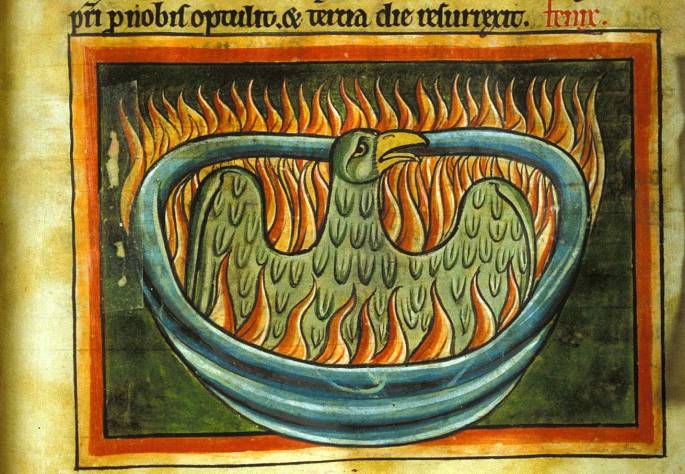
This is an image of Phoenix in a bestiary. This image can be found on google: https://www.google.com/url?sa=i&rct=j&q=&esrc=s&source=images&cd=&cad=rja&uact=8&ved=2ahUKEwjJtKGjvojfAhWOdN8KHW4YBlcQjRx6BAgBEAU&url=http%3A%2F%2Fwww.bl.uk%2Flearning%2Ftimeline%2Fitem126379.html&psig=AOvVaw24qTHAlo3PMIoUmk8YcMGW&ust=1544092264518174
Altogether, modern society has drawn on the this myth—that dragons and other mythical creatures existed in the Middle Ages and that people in the Middle Ages believed in such creatures—to create art and popular high fantasy media grounded in Medievalism. As the exemplar, George R. R. Martin roots his novel series in Medievalism, and though readers know it is high fantasy, of course, he uses this myth to ground his readers; when readers discover there were formally dragons in this world, they are not surprised because the Medieval setting is heavily associated with dragons and mythical creatures.
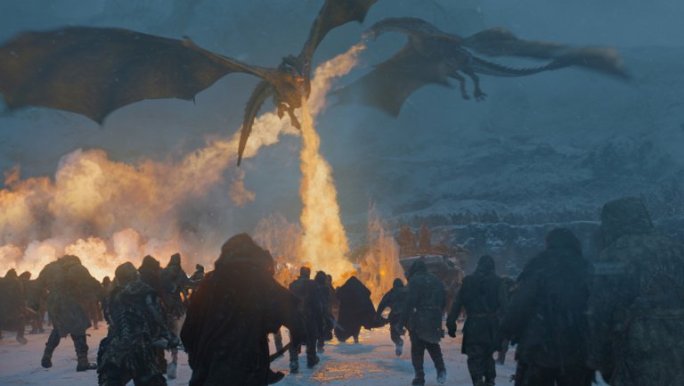
This is an image of the Game of Thrones depiction of Dragons flying and burning their enemies, and it can found from a google image search. It is proper of HBO: https://www.google.com/url?sa=i&rct=j&q=&esrc=s&source=images&cd=&cad=rja&uact=8&ved=2ahUKEwi5oKmRuojfAhWnhOAKHa_kANEQjRx6BAgBEAU&url=https%3A%2F%2Fwww.hollywoodreporter.com%2Flive-feed%2Fgame-thrones-why-daenerys-dragon-had-die-1031142&psig=AOvVaw1F7QB_k3pO75aQMTYyHiip&ust=1544091039619214
This association is easily contagious, especially when one is exposed to this myth at an early age. For example, Dave the Barbarian, a cartoon on Disney Channel, illustrates the protagonist and his friends in a setting inspired by Medievalism. The show allows the myth to thrive by once again associating the Middle Ages with dragons and fantastic creatures.
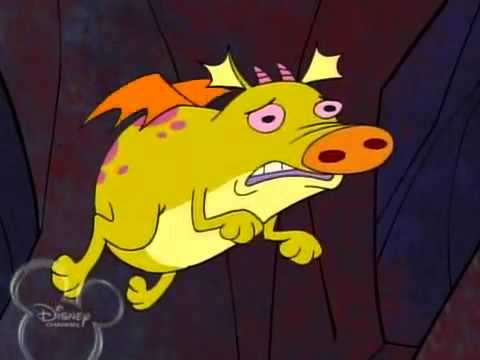
This is Faffy, the dragon depicted from Dave the Barbarian, which is property of Disney, and this image can be found on google: https://www.google.com/url?sa=i&rct=j&q=&esrc=s&source=images&cd=&cad=rja&uact=8&ved=2ahUKEwj3i-H1uojfAhUJVd8KHcjFBmIQjRx6BAgBEAU&url=https%3A%2F%2Fwww.youtube.com%2Fwatch%3Fv%3D_TNBWl0JYso&psig=AOvVaw03tAWQIRXo_XrAlNZBqrud&ust=1544091386401440.
While this myth has survived for a lengthy amount of time, it will continue to survive and influence generations if they are continually exposed to popular culture and media rooted in Medievalism that is associated with mythical creatures.
Notes
- Stevenson, Cait. “Seven Things You Didn’t Know About Medieval Dragons.” net.
- Stevenson, Cait. “Seven Things You Didn’t Know About Medieval Dragons.” net.
- Stevenson, Cait. “Seven Things You Didn’t Know About Medieval Dragons.” net.
- Badke, David. “The Medieval Bestiary: Animals in the Middle Ages.” 2015.
- Badke, David. “The Medieval Bestiary: Animals in the Middle Ages.” 2015.
- Badke, David. “The Medieval Bestiary: Animals in the Middle Ages.” 2015.
- Job 12:7-10 (New International Version).
- Stevenson, Cait. “Seven Things You Didn’t Know About Medieval Dragons.” net.
- Badke, David. “The Medieval Bestiary: Animals in the Middle Ages.” 2015.
- Paul Johnsgard and Karin Johnsgard. “Dragon Slayers of Medieval Times.” In A Natural History: Dragons and Unicorns. Washington State Magazine, Washington State University. Fall 2006.
- Stevenson, Cait. “Seven Things You Didn’t Know About Medieval Dragons.” net.
- Badke, David. “The Medieval Bestiary: Animals in the Middle Ages.” 2015.
- Badke, David. “The Medieval Bestiary: Animals in the Middle Ages.” 2015.
- Badke, David. “The Medieval Bestiary: Animals in the Middle Ages.” 2015.
- Badke, David. “The Medieval Bestiary: Animals in the Middle Ages.” 2015.
- Peter G. Sobol. 1993. “The Naming of the Beasts: Natural History in the Medieval Bestiary Wilma George Brunsdon Yapp.” Journal of the History of Biology, no. 1: 160.
- Peter G. Sobol. 1993. “The Naming of the Beasts: Natural History in the Medieval Bestiary Wilma George Brunsdon Yapp.” Journal of the History of Biology, no. 1: 160.
Bibliography
Badke, David. “The Medieval Bestiary: Animals in the Middle Ages.” 2015. Accessed December 4, 2018. http://bestiary.ca/index.html.
Paul Johnsgard and Karin Johnsgard. “Dragon Slayers of Medieval Times.” In A Natural History: Dragons and Unicorns. Washington State Magazine, Washington State University. Fall 2006. Accessed December 4, 2018.http://wsm.wsu.edu/s/we.php?id=217.
Peter G. Sobol. 1993. “The Naming of the Beasts: Natural History in the Medieval Bestiary Wilma George Brunsdon Yapp.” Journal of the History of Biology, no. 1: 160. http://ezproxy.bsc.edu/login?url=https://search.ebscohost.com/login.aspx?direct=true&db=edsjsr&AN=edsjsr.4331254&site=eds-live.
Stevenson, Cait. “Seven Things You Didn’t Know About Medieval Dragons.” Medievalists.net. Accessed December 4, 2018. http://www.medievalists.net/2017/04/seven-things-didnt-know-medieval-dragons/.
Annotated Bibliography
Badke, David. “The Medieval Bestiary: Animals in the Middle Ages.” 2015. Accessed December 4, 2018. http://bestiary.ca/index.html. This website is a long-term project by David Badke and contains over three thousand pages, included pictures, texts, commentary, etc. He has attempted to gather a plethora of information on the Medieval Bestiary and the significance of the bestiary in history. In his introduction, Badke asserts that “animal stories were immensely popular throughout Europe, North Africa, and the Middle East.” He claims, “there is a distinctly spiritual and even mystical aspect to the animal lore of the middle ages.” While in the Christian west, these people “believed the natural world…had been arranged as it was by God to provide a source of instruction to humanity.” This can be found in Job 12:7-10: “But ask the animals, and they will teach you, or the birds of the air, and they will tell you; or speak to the earth, and it will teach you, or let the fish of the sea inform you. Which of all these does not know that the hand of the Lord has done this? In his hand is the life of every creature and the breath of all mankind.” This is excellent commentary: “As doves are safe from their enemy the dragon as long as they stay in the shelter of the peridexion tree, so Christians will be safe from their enemy Satan as long as they stay in the shelter of the Church…. All of Creation was said to reflect the Creator, and to learn about the Creator one could study the Creation.” Regarding the creation of the bestiary, the Physiologus, a Christian text of interpretations of animal stories as religious allegories, and Isidore of Seville’s Etymologiae, an “encyclopedia of which part was about animals,” combined into the book “known as the bestiary.” It is debatable whether Medieval people genuinely believed in fantastic beasts, such as the unicorn or dragon; while some people “undoubtedly did,… others recognized them as the product of human imagination.” Badke addresses the religious complexity in relation to belief in these creatures: “For fabulous creature mentioned in the Bible (as unicorns and dragons are), the problem became more difficult; if the Bible is acknowledged to be the true word of God, any animal it mentions must surely exist. To that is added the medieval reliance on, and belief in the veracity of, the writing of ancient authorities such as Pliny and Aristotle, who clearly say these beasts exist “in the East” or “in Ethiopia” where others claim to have seen them.” Regardless if the beasts existed or not, they were utilized as “vehicles for moral and religious teaching as the more mundane animals of the European fields and forests.”
Paul Johnsgard and Karin Johnsgard. “Dragon Slayers of Medieval Times.” In A Natural History: Dragons and Unicorns. Washington State Magazine, Washington State University. Fall 2006. Accessed December 4, 2018.http://wsm.wsu.edu/s/we.php?id=217. This is a piece of from A Natural History: Dragons and Unicorns. As the title suggests, it describes the stories that would have been common in the Middle Ages in regards to the men who have slain dragons: the warrior Siegfriend, Saint George, and Gerolde. This work also offers historical accounts of how the Catholic church historically responded to the dragon tales involving saints.
Peter G. Sobol. 1993. “The Naming of the Beasts: Natural History in the Medieval Bestiary Wilma George Brunsdon Yapp.” Journal of the History of Biology, no. 1: 160. http://ezproxy.bsc.edu/login?url=https://search.ebscohost.com/login.aspx?direct=true&db=edsjsr&AN=edsjsr.4331254&site=eds-live. The authors begins his work by claiming that “bestiaries circulated widely among monasteries and private owners… [and] consist of brief notices of, usually accompanied by an illustration, of various kinds of mammals, birds, reptiles, and insects” (160). Sobol notes, “[W]hile Physiologushad used animals to teach Christian morals, the English bestiary evolved into a textbook of natural history” (161). The author mentions Yapp, whose introduction “declares that the English bestiary is not ‘an ignorant collection of moralities and old wives tales’ but rather is a respectful work of natural history” (161).
Stevenson, Cait. “Seven Things You Didn’t Know About Medieval Dragons.” Medievalists.net. Accessed December 4, 2018. http://www.medievalists.net/2017/04/seven-things-didnt-know-medieval-dragons/. This article discusses the dragon’s significance to people living in the Middle Ages. People associated dragons as the popular “ambodiment for Satan.” Regarding the dragon Fáfnir, which is the beast in Sigfried’s story, is basically a “giant snake.” Stevenson states, “Before [dragons] acquired the ability to fly, medieval dragons dropped out of trees onto people’s heads.” This is excellent commenetary:” For medieval people, dragons were just out of reach. Their homegrown saints exorcised demons in the form of dogs and battled Satan in the guise of frogs and beautiful women, but the great dragon-slayer saints came out of the ancient, pagan ‘East.’” Two women slayed dragons: Constantinople’s St. Elizabeth the Wonderworker and St. Margaret of Antioch, who is the “patron saint of nurses, exiles, Malta, peasants—and childbirth.”
